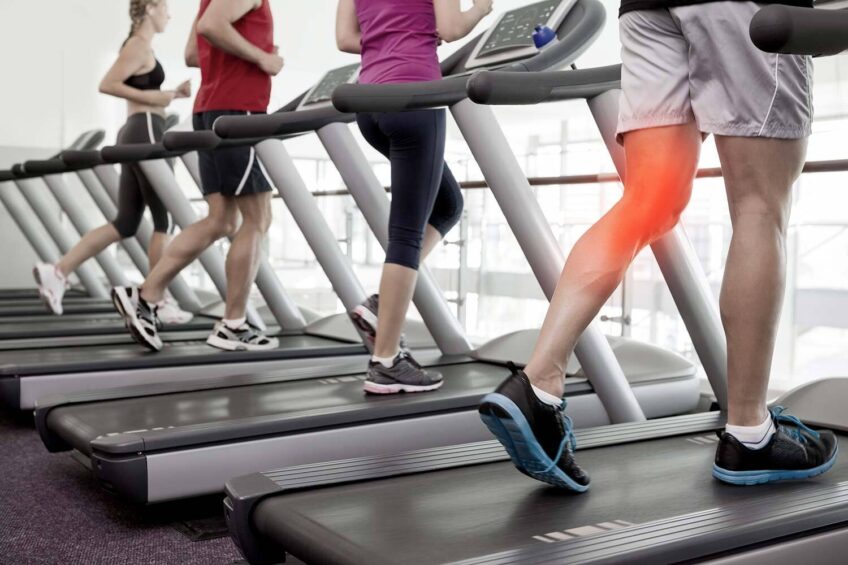Is Running on a Treadmill Bad for Your Knees?
While many people complain about knee pain after running on a treadmill, they’re probably not doing it right.

Running is terrible for your knees, right? I get asked this question often, and there seems to be a lot of misinformation around.
Occasionally, runners will tell me that running on a treadmill is harmful and it’s the repetitive high impact that is damaging to the knee joints.
But, the evidence doesn’t seem to support these opinions; let’s look at the facts:
Treadmill Running is Lower Impact Than Road Running
A treadmill has a semi-floating wooden board that sits below the belt. This board acts as a shock absorber, reducing the impact on your spine, knees, and heels.
Running on a Treadmill Decreases Stress on the Footstrike, Lowering Knee Impact
Road running is rarely completely flat and will usually include hills and cambered roads, which places additional stress on the footstrike (how you land when you run), increasing the impact on your knees.

In comparison, treadmills offer a flat, even running surface, as well as the ability to control the gradient of the terrain.
Running Does Not Increase the Risk of Osteoarthritis
A multi-year study of over 75,000 runners found that running did not increase the risk of osteoarthritis (a degenerative condition that affects your joints, including your knees).
In fact, the runners in the study were less likely to develop arthritis; these findings were supported by another study from 2017.
Running and Walking Place a Similar Amount of Stress on the Knees
The same study from above found that the impact of running was higher than from walking, but a runner’s feet strike the ground less often and more briefly. This means that over the same distance, running and walking place a similar amount of stress on the knees.
If you’re struggling with knee pain after running on a treadmill, it’s much more likely that you’re running incorrectly, not that there’s something wrong with running on a treadmill.
If that’s true, then there are some simple ways to prevent knee injuries from treadmill running.
Take These 7 Steps to Prevent Knee Injuries on the Treadmill
1. Purchase a Treadmill
Well, this should go without saying, but does your treadmill stack up? Does it have all the features you would want in a quality treadmill?
If you already have a treadmill, then congrats! The first step is complete. However, I strongly advise you to make sure your fitness equipment has all the features that will take your workouts to the next level -- take a look at this treadmill buying guide for amazing options.
2. Wear the Right Shoes
Whether you’re just starting with running, or are a running veteran, if you haven’t been fitted for running shoes, you’re at risk of injuring yourself. If your shoes are old or worn out, a trip to a specialist running shop should be your first stop.
As a rule of thumb, running shoes should be changed yearly or after around 500 miles.
3. Warm-Up Carefully
Before getting on the treadmill, do some low-load, long-duration stretching for longer than one minute per stretch to prevent knee pain. Important muscles to focus on are the hip flexors, quads, glutes, and calves.

Use a foam roller to warm up your calves, glutes, and IT bands before running.
Incorporate yoga - which is the best type of stretching you can get - it's just as effective as physical therapy.
4. Start Slow
Many runners, when they’re just starting, are guilty of trying to do too much too soon. Your body needs to build up fitness and muscle strength, so it's important to have rest days and to start at a slower pace.
For treadmill running, it helps to start with walking sessions where you can practice your footstrike and form while building up strength.
5. Focus on Getting Your Posture Right
Many people who struggle with treadmill workouts don’t have the right posture. It's easy to be distracted if you’re watching TV or listening to a podcast. To avoid injury, you need to keep aware of what your stomach, arms, back, and legs are doing.
To keep your body in the right position, you’ll want to engage your core, pull your shoulders down and away from your neck, straighten your spine to stay in alignment and concentrate on taking smaller paces.
If you're watching a TV ahead of you, that could be ok. However, we all do enough "looking down" at our phones all day, and using an iPad while sitting on your treadmill is not good posture.
6. Incorporate Treadmill Running into a Varied Exercise Routine
Even if you would classify yourself as a runner, it’s still important to cross-train as your body needs to be prepared for when you start building up your distances.

This will mean incorporating strength training and balance training into your exercise routine to strengthen your feet and hips, which will support your knee joint and help to prevent injuries. It will also contribute to improved all-over body strength and form.
Specific areas that might be contributing to knee pain include tight or weak calf muscles, tight quads, a lack of foot muscle strength, high or collapsed foot arches, and poor balance.
7. Pace Yourself
If you have knee issues, you’ll need to build up gradually. It’s better to focus on longer, slower runs than aiming for a personal best time. Focus on finding your natural stride, which can be more challenging on a treadmill (maybe even try closing your eyes to you do this!)
8. Get a Professional Opinion
If you’re still struggling with knee pain, schedule an appointment with a trainer or sports specialist who can examine your joints and muscles, as well as your running style, and make recommendations.
They’ll also be able to help you develop a cross-training recovery routine.
Wrapping Up
Let’s get back to the question - is running on the treadmill bad for your knees?
The simple answer is no; there’s nothing intrinsically wrong with running on a treadmill -- it’s the way you run that’s the issue.
Running on a treadmill has less of an impact on your joints (including your knees) -- it also assists your running and has a lower metabolic cost compared to road running.
Don't get me wrong, running outside has benefits too!
While many people complain about knee pain after running on a treadmill, the chances are that they’re not doing it right.
If you follow the seven steps above, you’ll be well on the way to running without pain on the treadmill.
I enjoy mixing up my exercise routine, and running on the treadmill is definitely an important part of my workouts.
But it's only one part of my overall fitness training. Treadmill running needs to be incorporated into a routine that builds whole-body strength and balance, not just cardio fitness.
In the long run, this will help you avoid injury as you’re not over-exercising specific muscles and ignoring others.
Tony Lee, MS, RD
Tony Lee, RD, MS, is a highly qualified and accomplished Registered Dietitian with a Master’s Degree in Nutrition Sciences. Tony brings over two decades of experience in dietetics, specializing in sports nutrition. Interests include studying all aspects of wellness, fitness, genetics, and peak health performance.














